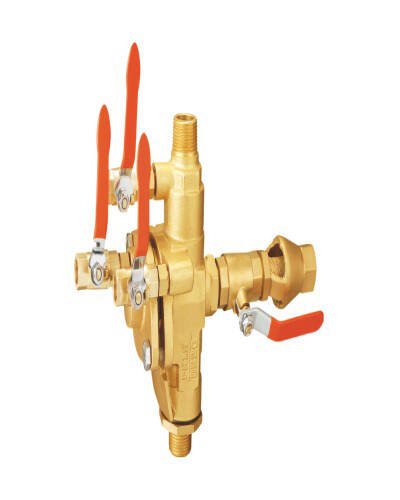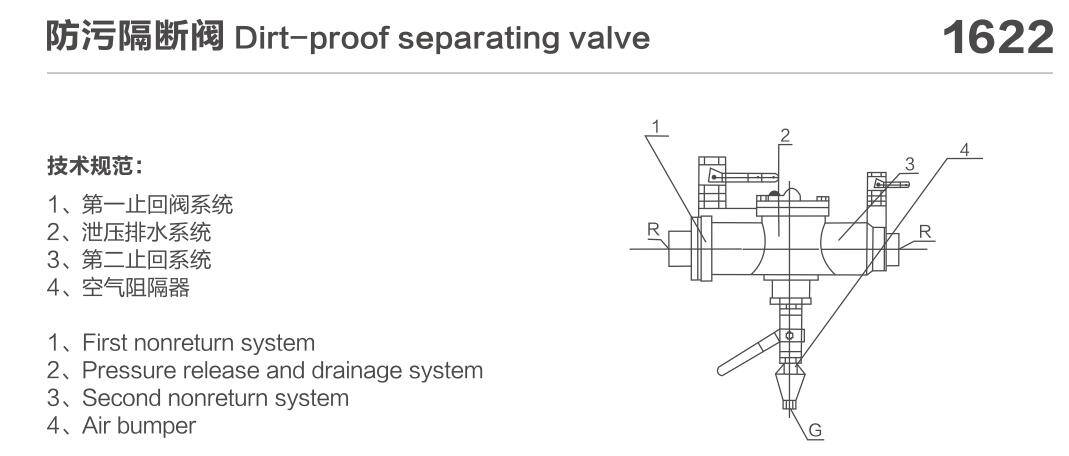
Partition Valve Series
1622
1622
Performance parameter
1. Product introduction:
The 1622 anti-fouling shutoff valve is used to place a safety device for backflow pollution in domestic water pipelines, and a novel valve to prevent backflow pollution of drinking water to ensure the sanitation and safety of daily necessities.
2. Product structure:
The 1622 safety type anti-fouling isolation valve is composed of a two-stage non-return system and a drainage and pressure relief system. The upper cavity of the drainage pressure relief system is connected with the inlet end of the first-stage non-return system. The first and second non-return systems are mainly composed of valve body, water inlet joint, valve clack, gasket, spring and so on. The drainage pressure relief system is mainly composed of valve cover, diaphragm, valve core, gasket, drainage port, spring, air blocker, etc.
3. Working principle:
The 1622 anti-fouling block valve is to add a drainage pressure relief device to the secondary check system, so that even if the secondary check seal is damaged at the same time, it can also play a role in preventing backflow pollution. How it works:
1. Normal water supply:
a. Clean municipal domestic water flows from the first-stage non-return system through the drain to the second-stage non-return system outlet to supply water to the user. The first-stage non-return system inlet high-pressure water enters the upper cavity of the drainage diaphragm, and the lower cavity of the diaphragm is connected to the first The outlet of the second-stage check valve (the inlet of the second-stage check valve) is connected. Due to the existence of a certain pressure difference, the valve disc is pushed down, the drain is closed, and the anti-fouling shutoff valve is normally supplied with water;
b. When there is no user in the valve pipeline and the water is still, if the inlet pressure remains unchanged, there is a pressure difference before and after it, and the drain is still closed;
c. If the inlet pressure drops, when the pressure difference between the front and rear drops to a certain value, the spring pushes the spool upwards and the drain opens to release the pressure. When the pressure is released to a certain differential value with the inlet pressure, the drain closes again.
2. When the seal fails:
After the anti-fouling shutoff valve, the pressure of the pipe network rises and exceeds the inlet pressure before the valve. If the second check valve is sealed without leakage, high-pressure water will not flow back, the drain diaphragm maintains the original pressure difference up and down, and the drain closes. Do not relieve pressure. When the seal of the second check valve is broken and leakage occurs, the pressure before the second-stage check valve rises, causing the pressure difference between the upper and lower sides of the drain diaphragm to decrease, the drain opens, and the drain pressure is released; at this time, such as the first-stage check The valve seal is broken at the same time, because the high-pressure water flowing back from the second-stage check valve has been relieved and reduced, so it will not flow back to the first-stage check valve.
3. If the water supply pressure drops continuously during the water supply process, the pressure on the upper part of the drain diaphragm will drop, and the safety drain control spring will push the valve core to open the drain to drain water. When the inlet pressure drops to zero or negative pressure, the drain is fully opened, the water is discharged, and the air enters the vacuum chamber from the drain, thereby preventing the phenomenon of siphon backflow.
4. Main performance parameters:
Working pressure: 1.6MPa
Use medium: clean water
Medium temperature: ≤60℃
5. Installation position of anti-fouling shutoff valve:
1. The tap water pipe network is connected to the back of the user's water meter.
2. Connect non-domestic drinking water and sewage pipes to the domestic water pipes and install them at the beginning of the outlet pipes.
3. On the inlet pipe of the drinking water tank (when water enters the bottom of the tank).
4. When the drinking water pipeline is connected in series for pressurization, it is installed on the suction pipe of the pump.
